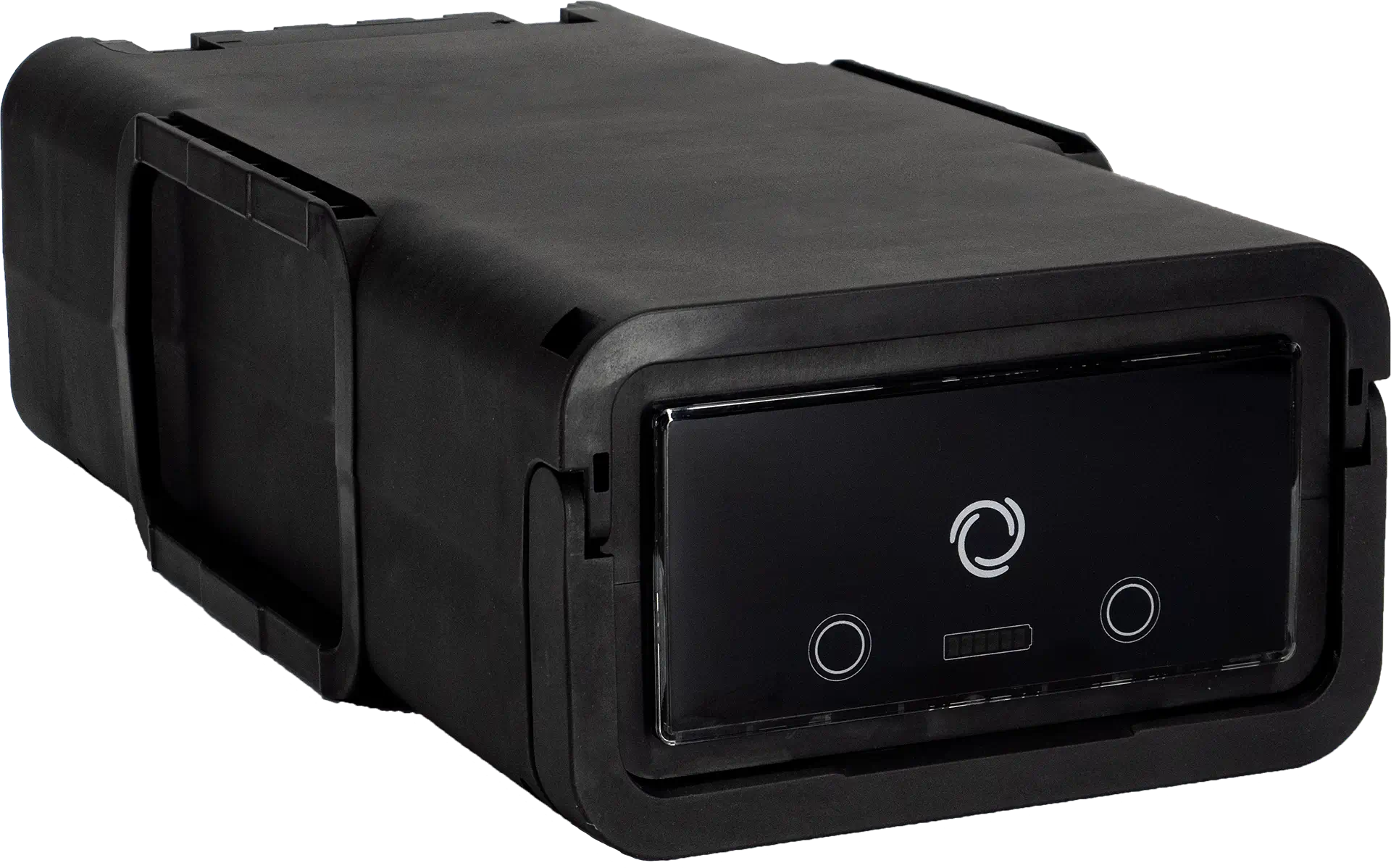
BOS battery S
Installation & User Manual
Product name: BOS battery S & BOS battery S Bluetooth
Product numbers: 98904313, 98905110
- Release date:
- June 2022
- Last revision:
- 24. March 2025
Table of Contents
Package contents
- Quick manual
- Device BOS battery S Part No. 98904313
Optional accessories
- Power cable BOS battery 900 mm M6 to M8 Art. No. 98904570
- BOS battery S double pack mounting set Art. No. 98904640
- BOS bus terminator Art. No. 98904271
- BOS CANopen auf USB Serviceadapterset Art. No. 98904305
- BOS bus communication cable 170 mm Art. No. 98904266
- BOS bus communication cable 400 mm Art. No. 98904561
- BOS bus communication cable 650 mm Art. No. 98904641
- BOS bus communication cable 1000 mm Art. No. 98904312
- BOS bus service interface cable set 1000 mm Art. No. 98904557
General Information
Thank you for purchasing a high quality, german made product from BOS Balance of Storage Systems AG. We worked strictly according to german engineering standards in order to deliver valuable energy services for our customers. In case of technical problems or comments of any kind, please contact the local distributor for support.
BOS battery S is a state of the art lithium battery for various applications. It can be used as pure lithium battery or in hybrid battery mode in combination with lead acid batteries to add capacity to lead acid batteries in solar and any other kind of energy storage systems.
When used as pure lithium battery the battery can be used as a drop in replacement to so far used lead acid batteries. The BOS battery S has the footprint of 95 Ah AGM battery, two BOS battery S on top of each other have the same height as a 95 Ah AGM battery.
When used in hybrid battery mode: The BOS battery S takes most of the charging cycles while the lead acid battery provides inexpensive backup capacity. The lead acid battery is charged with higher priority, the BOS battery S takes all surplus energy. This helps to increase the lead acid battery life. The Lithium battery recognizes the lead acid battery voltage and automatically starts to support the lead acid battery with a maximum current of 80 A per unit as soon as loads are connected. Bigger loads get supplied by the lead acid and the BOS battery S in parallel, resulting in smaller currents for the whole system.
Safety instructions
- Please read and understand the whole user manual before installation and usage of the BOS battery S.
- Use the device only in combination with a LiFePO4 or lead acid battery charge controller
- Do NOT mix up the + (plus) and – (minus) poles of the battery.
- Do NOT connect anything to a damaged battery. It could heat up, catch fire or explode.
- Do NOT open the battery pack. Danger of short-circuiting. Opening the BOS battery S device voids any and all warranty claims.
- Do NOT place device in direct sunlight.
- Keep the device within the defined temperature range.
- Protect the BOS battery S against heat (e.g. prolonged sun exposure) and fire and from water. Do NOT store or operate the BOS battery S near hot or flammable objects.
- Install this device step by step as written in this manual for best results.
- After installation, the device needs to be fully charged.
- Follow all safety precautions during installation of device & handling batteries.
- Improper handling of batteries may introduce a risk of battery explosion.
- Keep batteries away from children & animals.
- During handling of batteries no smoking or exposure to fire.
- Wear eye protection during installation process.
- When working with a battery and BOS battery S remove all personal metal items like watches, rings, necklaces and bracelets. Metal items in contact with the battery terminals might cause a short circuit with a very high electric current, which may heat up and melt nearby objects and cause severe burns. If you need to use metallic tools, they must be properly insulated.
- Keep the BOS battery S away from paper clips, coins, keys, nails, screws or other small metal objects, that can make a connection from one terminal to another. Shorting the battery-pack terminals together may cause burns or a fire, even though the battery has internal short circuit protection functionalities. For short-circuiting damage caused in this manner, any and all warranty claims shall be invalid.
- Use electrically insulated tools for connecting cables.
- The mounting and the electrical connection may only be carried out by trained specialists.
- Incorrect operation can damage system components.
- Factory labels and markings must never be altered, removed or rendered unreadable.
- This device contains sensitive electronics, so take care during installation and use.
- Consider all relevant official safety instructions during transportation of the device. Safety instructions might vary depending on the mode of transport and on local country regulations.
- Check the recycling information at the end of the user manual for disposal of device
- When used in hybrid battery mode:
- Only connect to 12 VDC batteries of the following types:
- Lead storage batteries with liquid electrolytes
- Sealed lead acid batteries – GEL or AGM
- Use the device only in combination with a lead acid battery and a lead acid charge controller, do NOT connect loads or power sources directly to the lead acid battery nor to the BOS battery S.
- The device must not be connected to a lead acid battery if it has a damaged casing.
- Lead acid batteries can generate explosive gases during operation. Never smoke, allow flames or sparks near the battery. Make sure to keep sufficient ventilation around the battery and read the lead acid battery user manual.
- Do NOT use with nickel cadmium batteries, nickel metal hydride batteries or other battery types.
Application Scope
- The primary application of the BOS battery S is to supply power in electric systems in recreational vehicles, recreational boats and in stationary storage systems (e.g. powered by renewable energy in the area of solar energy).
- This device is for residential, recreational & small commercial operations.
- The BOS battery S cannot be used as starter battery.
- This device is available with different controllers that can support 12V, 24V and 48V applications. Note that for 24V application a minimum of 2 BOS battery S modules is needed, for 48V applications 4 BOS battery modules S respectively. A lithium or lead acid charge controller is needed for correct operation.
- Modules with a 12V Controller unit can not be externally connected in series to achieve higher voltages. Please contact your distributor to get a 24V or 48V Controller to be used with the battery modules for acchieving higher voltages.
- The device is not permitted to be mounted in outdoors, underside, engine compartment or exposed areas of interior spaces (e.g. side pockets in the trunk, outer wet chamber, spare wheel recess).
- Failure to follow this precaution can cause damage to this device and the energy source to which it is connected.
- Consult authorized supplier if device is to be connected in nonstandard configuration.
- If used in hybrid battery mode, sizing of lead acid battery needs to fit to the overall system design. For long lifetime lead acid battery must frequently be charged to 100%.
- If sizing of the system is not done within the specification warranty becomes void.
- Failure to comply with correct product usage or neglecting the user manual, the warranty and guarantee becomes void.
Guidelines and certifications
The BOS battery S is designed and verified according to the following standards/guidelines:
- CE
- UKCA
- UN38.3
- IEC 62619: 2017
- IEC 62133: 2012
- (EMC) Directive 2014/30/EU
(electromagnetic compatibility) - DIN EN 55014-1:2018-08, DIN EN 61000-6-2:2019-11
- DIN EN 61000-4-2:2009-12, DIN EN 61000-4-3:2011-04
- DIN EN 61000-4-4:2013-04, DIN EN 61000-4-5:2015-03
- DIN EN 61000-4-6:2014-08
- ETSI EN 300 328 V 2.2.2
- ETSI EN 301 489-17 V3.2.4
- ETSI EN 301 489-1 V2.2.3
- EN 62368-1:2020/A11:2020
- EN 62311:2008
This device complies with part 15 of the FCC rules. Operation is subjected to the following two conditions:
1. this device may not cause harmful interference and
2. this device must accept any interference received, including any interference that may cause undesired operations.
Furthermore, the BOS battery S was successfully subjected to a temperature cycling test as well as a shock and vibration test. All tests were carried out in accordance with LV124. The BOS battery S is approved for use in motor vehicles and bears the ECE test mark E1*10R06/02*9807*00

Technical specifications
Overview

2. Push button right
3. State of charge display and error indication
4. Ambient light feedback
5. Snap-out handle
6. Optional fixing point for lead acid mounting clamp
7. Optional fixing point for double pack fixing
8. Plus pole connection
9. Minus pole connection
10. Internal BOS bus communication connector (looped through), must be terminated
11. Optional external communication bus connector for usage with communication extensions
System Functions
Protection & integrated heater
BOS puts very high stress on providing a safe and reliable product, this is why the battery is reduntanly protected against overcurrents, by using an integrated melting fuse as second level disconnect protection functionality. The software driven overcurrent protection through MOSFETs is activated before the melting fuse blows, hence in normal operation (even in cases of overcurrents, short circuits etc.) the melting fuse will not blow, but it serves as additional safety line in case of unlikely software or hardware problems. Due to the integrated melting fuse the short term peak overcurrent levels are limited to avoid a blown melting fuse, in exchange unprecedented safety will guarantee comfort and security.
Due to the intelligent battery management, the BOS battery S is furthermore fully protected against overload and deep discharge as well as overcurrent, short circuits, wrong polarity and too high or too low temperatures. In cold conditions (<10 °C cell temperature) the integrated heater heats up the BOS battery S to operating temperature once charging voltage is applied. This happens before the battery allows charging to avoid damage to the cells due to the cold temperatures. At cell temperatures below -20 °C no discharge of the device is possible. The integrated heater allows for heating up batteries from <30°C to allow battery charges even in roughest environments. Once the integrated heater has warmed up the BOS battery S and the thresholds of -5 °C for charging and -20 °C for discharging are passed, the BOS battery S starts charging/discharging up to a certain current limit. See paragraph “temperature compensation during charging / discharging” for further details on charge / discharge characteristics.
The device is short circuit protected. In case of short circuit the device will show an error message (see details under chapter “troubleshooting”). The device is wrong polarity protected when it is connected to a charger or other voltage source with wrong polarity. In case of connection with wrong polarity the device will show an error code (see details under chapter “troubleshooting”). Please note that the battery can only protect itself from wrong polarity due to a wrongly connected voltage source or charger: if appliances are connected, which are not reverse polarity protected, they might get damaged. All errors are automatically resetted after a certain time. If overload errors occur again after restart, the timeout until the next retry is doubled. If the error persists, after several times of doubling the reset time, the BOS battery S will try to recover once a day automatically.
Charging
The BOS battery S can be charged with max. 80A per battery. If higher charging current is applied, the battery will switch off automatically. When used in cold temperatures, the maximum charging current will be gradually reduced. Please refer to “Protection & integrated heater” and to “temperature compensation during charging / discharging” for details in cold conditions. Note that the internal heater will be turned on as soon as a charger is connected and active at battery temperatures below 10°C.
The BOS battery S is only allowed to be charged through either (1) a charging device from the list of natively compatible devices, (2) a LiFePO4 charger or (3) a lead acid battery charger.
(1) If you have a charging device that is natively supported through the BOS CANbus / or a BOS connect and have the communication actively set-up, then no settings for charging are needed as the communication is done diretcly between the BOS battery S and the supported charging device. A list of natively compatible devices and guidelines is found online at www.bos-ag.com
(2) Alternatively the use of a LiFePO4 battery charger is recommended with the following recommended specifications/settings:
- IUoU charging algorithm
- Charge current: recommended 40 A, max. 80A
- Absorption voltage: 14,0V
- Absorption voltage duration: 3h
- Float voltage: 13,6V
- charger low temperature cut-off: 10°C (lower charging currents are allowed at lower temperatures and can be configured in more detail, see chapter “Maximum currents over temperature”)
(3) The BOS battery S is designed to also work with most standard lead acid battery chargers. Some chargers are configurable. Then the same values as stated above for LiFePo4 are recommended. If a charger without changable settings is used, please note the following points:
- do not use temperature compensation of the charge voltages. If the lead acid charger comes with an external temperature sensor, it is recommended to disconnect it.
- if your charging voltage setting is e.g. 14,7V, and the charge voltage rises over approx. 14,2V, the BOS battery S will disconnect charging and only allow discharging. The lead acid battery charger still recognizes the voltage of around 14,2V and stays active, a proper charge of the BOS battery S hence works also with a standard lead acid battery charger.
- if the battery is too cold for the applied charging current, it will disconnect charging and only allow discharging. The battery will continue to heat up using the internal heater and once more charging current is allowed, the charge will continue automatically.
- note that if the charging voltage is below 13,8V, the battery might never get fully charged. Over long periods of time SoC calculation will get less accurate and cell balancing will not work properly.
When used in hybrid battery mode: The lead acid battery is charged with higher priority. After the lead acid battery is charged to approx. 80% the BOS battery S starts being charged in parallel. However, it still leaves sufficient energy for the lead acid battery to be properly fully charged. The charging current on lithium side is limited to a maximum of 80A per BOS battery S, for instance 4x BOS battery S in parallel can be charged with up to 320 A. Use a standard lead acid battery charger to charge the whole battery system.
Discharging
The BOS battery S can be discharged with max. 80A per battery. When used at very hot or very cold conditions, the maximum discharge current will be reduced.
Short term higher peaks are possible at normal operating temperatures in the following range:
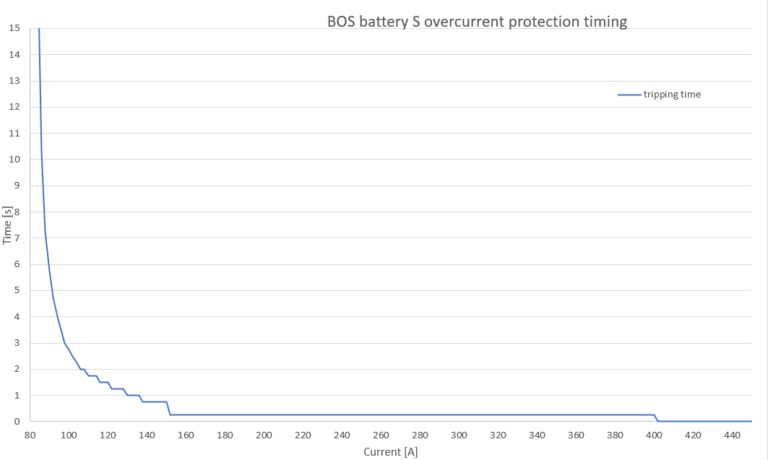
Note that the BOS battery S has a soft start functionality to support start up of large inverters (large inrush currents into the built-in capacitors of the inverters are buffered by the soft start function). For such capacitive loads, it is therefore recommended to switch off the battery prior to connecting the load. After wiring is complete and the load is connected, the battery can be turned on and will start with a soft-start algorithm. This startup method is also used after recovery from a detected short circuit or other errors.
When used in hybrid battery mode: At the beginning of each discharge phase, the BOS battery S will be discharged first (given that the BOS battery S has not been empty). Depending on the load, the BOS battery S is doing all the work until the BOS battery S is almost completely discharged, while the lead acid battery remains charged. Once the BOS battery S is discharged the lead acid battery will be discharged (if load continuous). Therefore, in charging & discharging phases the BOS battery S is supporting the lead acid battery. The current is limited to a maximum of 80 A per device, for instance 4x BOS battery S can thus together support the lead acid battery with up to 320 A. Currents higher than the nominal rated currents of the BOS battery S are supported by both, the BOS battery S and the lead acid batteries, resulting in smaller C-rates for both batteries.
Sleep mode
Several sleep modes protect the battery from a deep discharge of the Li-cells. When it is almost empty, it will turn off the output. In the first stage, the behaviour is configurable via the communication BOS bus. With these settings you can for instance choose to force the battery ON until is is completely empty, or having a current limited output until it is completely empty (completely empty means that the battery is still protecing itself from deep discharge and leaves sufficient capacity to not get damaged, see next point for more details). Also switching back on from time to time is possible in this sleep mode.
Once the battery is completely empty, it will go into a deeper sleep state where waking up is possible by connecting a charging voltage, pressing one of the two pushbuttons of the battery display, or using the wakeup pin at the communication bus (for instance by using a BOS connect that has a push button that is linked to the wakre-up pin). The communication bus is still responsive in this state.
Once the battery is close to being deep discharged with danger of cells getting damaged, the communication bus is deactivated and the controller does not communicate with its battery modules anymore. In this state, the orange LED at the user interface will indicate “unplugged” when a pushbutton is pressed. Waking up is possible by connecting a charging voltage (recognizing the charging voltage might take up to one minute in this state), pressing one of the two pushbuttons of the battery display, or using the wakeup pin at the communication bus (for instance by using a BOS connect that has a push button that is linked to the wakre-up pin).
If one of the Li-cells is critically deep discharged and therefore damaged, the BOS battery S system shuts down completely into a safety mode to protect from potential dangers that could occur when recharging depleted lithium cells. The error Code “module state” is reported, see details in error code table. Neither charging nor discharging is possible anymore. In this case, please contact your local BOS dealer for support.
When used in hybrid battery mode: The behaviour is similar as in Lithium-only mode: The battery will go off and at before reaching a deep discharged state it will stop any communictation. It can be re-enabled by applying a charging voltage, as long as no cell is damaged.
OFF mode
Maximum currents over temperature
The maximum possible charge and discharge current depends on the battery temperature. The maximum currents are shown in the graph below. If these values are surpassed by the charger or the loads, the battery protects itself by disconnecting from the charging device or the loads.

When used in hybrid battery mode: the maximum charge / discharge currents in hybrid battery mode are as shown in the following graph. This does not mean that the charger or loads need to limit the currents, because exceeding currents will be flowing to/from the lead acid battery. The BOS battery will limit its own maximum currents, the following graph just explains how the battery S behaves:

Installation
Please read and understand our general information before starting the installation.
Mechanical installation
In general, the BOS battery S can be installed in any mounting direction. Fixing with standard lead acid battery clamps works only if the BOS battery S is laid down flat on its largest surface as shown in the picture below. For mounting two BOS battery S on top of each other you have to use the BOS battery S double pack mounting set consisting of two metal clamps and 4 plastic supports. Please ask your dealer for optional frames for quick mounting and swap functionalities.
In case of parallel connection of two BOS battery S on top of each other, note that the maximum number of BOS battery S mounted on top of each other is two. Make sure that BOS battery S enclosures are mounted firmly together using the BOS battery S double pack mounting set Art. No. 98904640. This set consists of 2x BOS battery S steel connection clamps, 4x BOS battery housing alignment pins, 1x BOS bus communication cable 170mm and 2x BOS bus terminators.
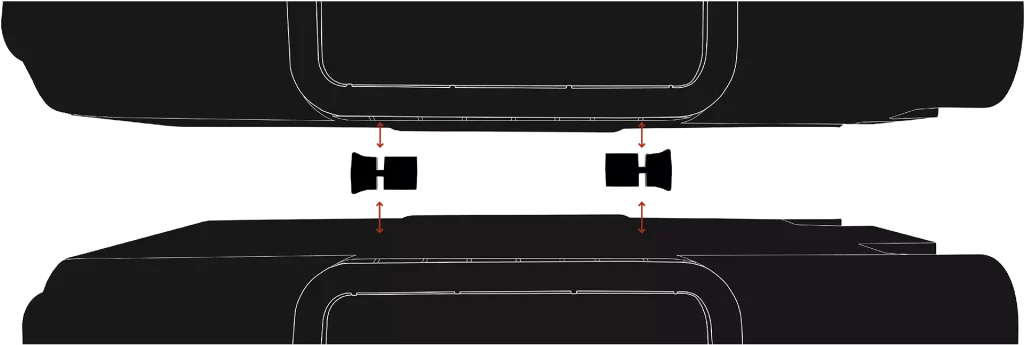
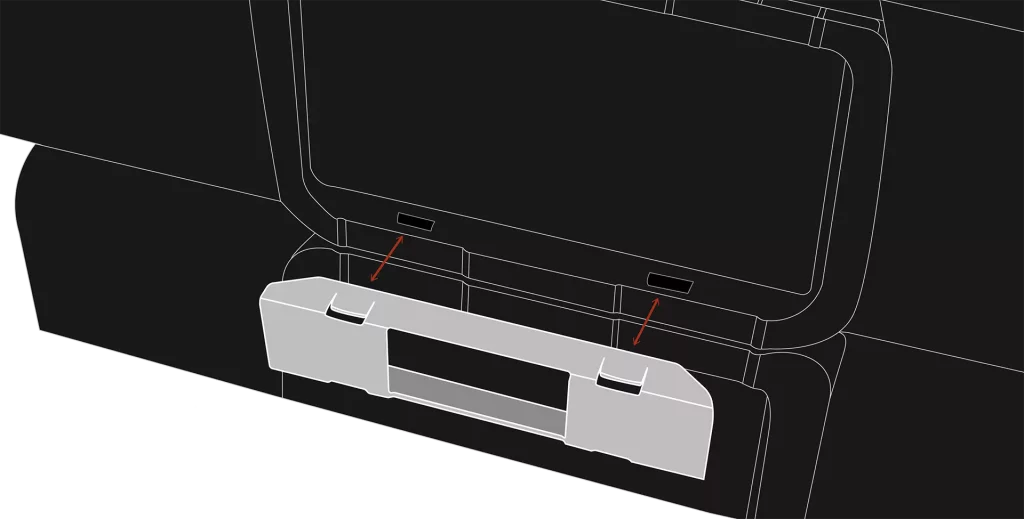
For mechanical fixing of the second BOS battery S on top of the first one, insert 4x BOS battery housing alignment pins in the lower BOS battery S as shown in the picture below. Then add second BOS battery S on top and use BOS battery S steel connection clamps on both sides to tightly fix the two batteries together. Details are found in the installation manual that comes with the BOS battery S double pack mounting set.
Electrical installation
As the voltage of the battery is in a safe range, you can do the electrical connection with the battery being turned on. However if you have the possibility it is recommended to turn all batteries into the OFF mode. If you press any button, the orange signal LED should come on for one second, indicating the battery is off. There should be no voltage on the terminals. If it is not, you can enter OFF mode by pressing both buttons the same time for minimum 3 seconds.
The BOS battery S has to be connected to either a standard lead acid battery charger or a lithium battery charger. It is important to choose the right size of connection cable, depending on the maximum currents. Make sure that wiring is done according to DIN VDE 0298-4. Optionally the Power cable BOS battery 900mm M6 to M8 Art. No. 98904570 is available. Several sets of connecting cables might be required.
Details on the electrical connection are explained in the following.

| 1 | 2 | 3 | 4 | |
|---|---|---|---|---|
| M6 plus pole connection | M6 minus pole connection | Communication interface BOS bus (based on CAN) | Communication interface external | |
| To plus of load / charge controller or lead acid battery when used in hybrid battery mode | To minus of load / charge controller or lead acid battery when used in hybrid battery mode | Optional to next BOS battery S or other BOS bus components. If only one component is plugged in, the other connector must be terminated using a BOS bus terminator. | Optional communication output for usage with communication extension |
Simply connect the BOS battery S to the charge controller / inverter/charger by using the power connectors (1 & 2). Pay attention to right polarity as this could damage devices in the periphery. Start with the plus connection of the electrical wiring at power connector 1. Then continue with minus connection at power connector 2. Make sure to use the provided M6 bolts with washer and spring ring for connecting the power cables to the BOS battery S. Make sure that cable shoes are properly placed on the poles. The bolts are to be tightended with 3,5 – 4 Nm torque. The maximum stack height between the screw dome and the washer is 6mm. Please refer to the next picture for details:

Doublecheck that all screws are tightended properly, as a loose connection is a potential fire hazard.
For parallel connection of multiple batteries, make sure to wire as depicted in the following graphs:
When connecting each BOS battery S with a separate cable harness, make sure that all cables going from the battery poles to the parallel connecting hubs are of the same cable length and cable size.
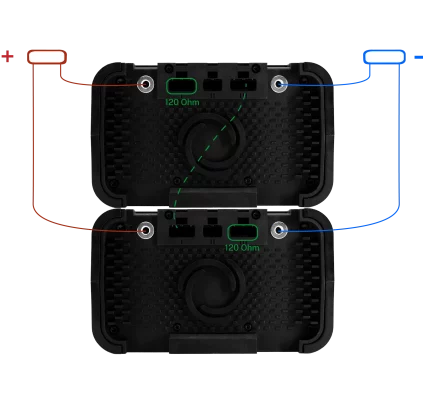
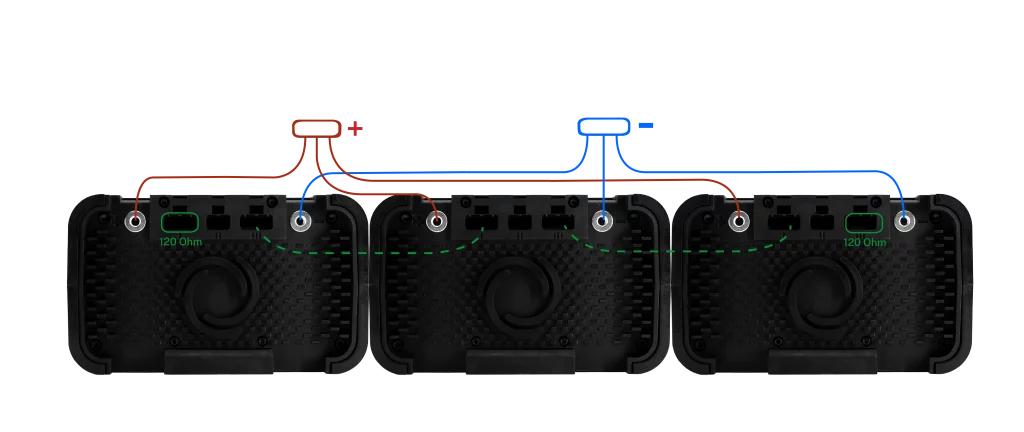
When looping directly in parallel, make sure to connect to loads/charging devices at both ends of the battery bank as shown in the following graphs:
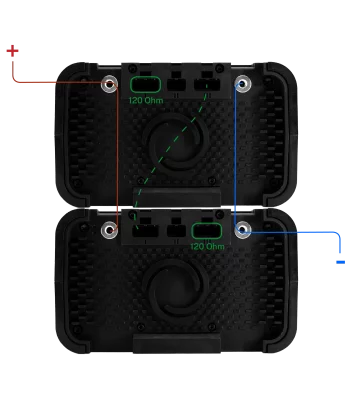
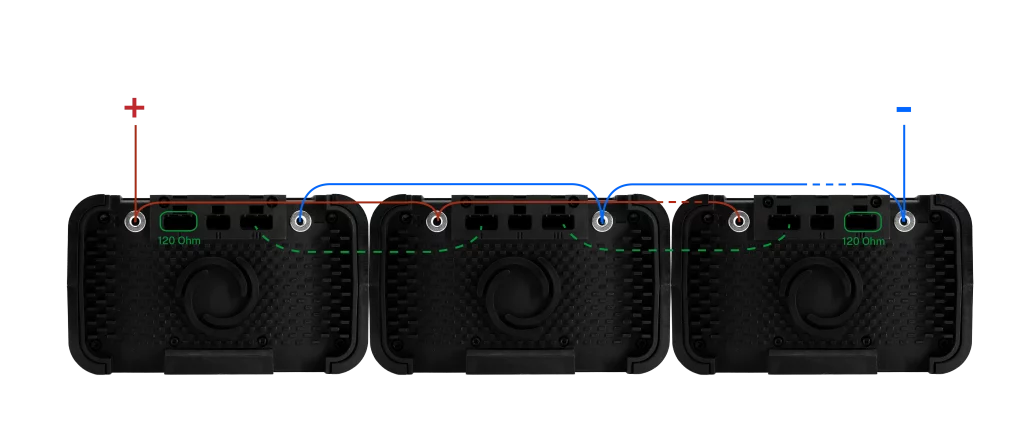
Also make sure to connect the BOS battery S to each other through the BOS bus communication ports 3 using the BOS bus communication cables. Make sure to terminate the BOS bus communcation ports 3 with the BOS bus terminators (120 Ohm) on all open ends.
The optional signal outlet 4 for connection to other buses using the optional inbuilt extensions can be connected according to the manual of the used extension.
When used in hybrid battery mode:
The BOS battery S can be connected in parallel to the lead acid battery. Please note that a standard lead acid battery charge controller is needed. No special additional charge controller is needed for the BOS battery S. Make sure to only connect BOS battery S at the same voltage like the lead acid battery (e.g. if you have one 12V lead acid battery, you can match that with any 12V configuration of BOS battery S). It is important to choose the right size of connection cable, depending on the maximum currents. Make sure that wiring is done according to DIN VDE 0298-4. Optionally the Power cable BOS battery 900mm M6 to M8 Art. No. 98904570 is available.
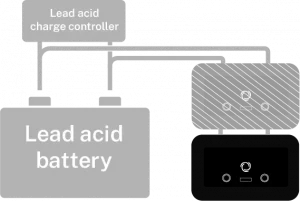
The picture above is a basic visualization of the system connection when used in hybrid battery mode
Commissioning & Decommissioning
Once mechanical and electrical connection is done, please make sure the battery is in correct mode (Lithium-only or Hybrid in combination with lead acid). You can switch from one to another operting mode anytime via the BOS bus communication or pressing the touch buttons 1 and 2 of any battery shortly in a certain pattern. This is to make sure the mode is not changed unintentionally. The pattern is as follows:
- right
- left
- right
- left
- left
- left
Afterwards, if you press the left button for more than 3 seconds, the battery will switch to hybrid mode. This will be signaled by the SOC LEDs running from right to left. If you press the right button for more than 3 seconds instead, the battery will switch to Lithium-only mode. This will be indicated by the SOC LEDs running from left to right.
Note that all batteries, which are connected by the BOS bus will automatically also switch their mode the same way. It is not possible to use both hybridmode batteries and lithium-only mode batteries in one system.
Once the mode is set and all connections are done, the battery can be turned ON by pressing both buttons the same time for minimum 3 seconds. (note: in case the battery was ON already before, this would turn it OFF again).
The battery will automatically start up and enable its voltage output. After few seconds, please push one of the pushbuttons to check the status of the product (see details in next chapters). It is recommended to fully charge the system once connected. A full system charge is needed in order to allow for cell balancing and to re-initialize the state of charge calculation.
For decommissioning follow these steps:
1. Switch off all loads and connected chargers
2. If possible, turn off the battery by pushing both touch buttons the same time for minimum 3 seconds (if you can’t reach the display push buttons you can also proceed without truning OFF as the voltage is in a safe range)
3. Disconnect the minus connection
4. Disconnect the plus connection
5. Disconnect all other communication cables
6. Dismount the battery
User interface
The display is off by default to save power. To activate the display, just press one of the two push buttons.
Touch pushbuttons
The two touch buttons can have different functionalities depending on the state of the battery:
- during normal operation, pressing any button shortly will wake up the display and show the State of Charge as described below
- by entering a certain pattern, the battery can be switched from Lithium- to Hybrid mode and back. Please refer to chapter “commissioning”
- by pressing both buttons at the same time for min. 3 seconds, the battery can be manually toggled ON or OFF. In OFF mode, power consumption is minimized and the battery can stay for long time with minimum self consumption. Power consumption can even further be decreased by disconnecting all communication cables.
- by pressing only the right button for min. 3 seconds, the battery will display its State of Health in a blinking fashion
- when an error occured and the battery is in error mode (see “Orange warning indication light” and “trouble shooting”), by pressing the right button for min. 3 seconds, the error can manually be cleared. Note that most errors clear themselfes without interaction as soon as the error does not persist anymore.
- if the battery is in a very deep discharged state and the outputs are turned off, pressing any button will wake up the battery and the outputs are forced to turn on for about 30 seconds. This feature can be used when using a charger which needs a battery voltage to start up. Warning: Using this functionality to further discharge the battery may damage the battery by deep discharging the cells.
Button feedback lights
Six white status indication lights
if any of the two buttons is pressed and no orange warning indication is lights up, the six white status LEDs represent the state of charge (SoC) of the battery. If all of them are on, the battery is fully charged. If only the left one is blinking, the battery is discharged. During charging, an animation will indicate that the battery is charging. During discharging, an animation will show that the battery is being discharged.
In some special cases, other information can be shown by the status LEDs:
- if the orange indication LED lights up, the six white status LEDs will have a different meaning (see below)
- after clearing an Error or waking up the battery using the external wakeup signal, an animation will be shown here
- after switching the battery mode to OFF mode, hybrid mode or Lithium-only mode, an animation will be shown here
- during firmware update of the controller, an animation is shown
- if an identification command is sent via BOS bus communication, an animation is shown
- if no error is present on the controller and the right button is pressed for more than 3 seconds, the module will display its own state of Health (SoH) in blinking fashion for fife seconds on the six while status LEDs
White ambient light
during normal operation, when a button is pressed, the ambient light will smoothly dim up and stay on while the status lights display the SoC information. When in hybrid mode, the ambient light will continuously dim up and down a little to visualize the hybrid charging function with a lead acid battery. During charging, the ambient light will turn clockwise, during discharging it will turn counter-clockwise. After an error (e.g. short circuit), the ambient light will visualize the problem by rapid flashing. If an identification command is sent via BOS bus communication, an clockwise turning animation is shown on the ambient light.
During OFF mode or if the module is not connected to a Controller (see below), the ambient light will remain off even upon pressing a button.
Orange warning indication light
If the Orange warning LED lights up for approx. 1 second after pressing a button, the Module is turned off. This can have several reasons:
- The battery is manually turned off by the user or via a BOS bus communication command. It can be turned on by pressing both buttons at the same time for minimum 3 seconds. It could also be turned on by a BOS bus communication command
- The battery is unplugged: There is no Controller unit attached to the module.
- The battery is in deep discharge protection mode: The controller does not communicate to the module anymore to save power. Please apply a voltage to the terminals to recharge as soon as possible.
- Communication failure: the module is not able to communicate with a controller. Please check mechanical mounting of the control unit in the battery module.
If the orange warning LED lights up for some more seconds after pressing a button, there is a error present on the controller. The six white LEDs represent an error code. Please refer to the chapter “Trouble shooting”.
Bluetooth Interface (only with optional Bluetooth module)
Please scan the provided QR code for bluetooth link. For additional information please refer to the user manual of your SIU.
The Bluetooth version contains FCC ID: S9NBNRGM2SA & S9NBNRGM2SP.
Troubleshooting and FAQ
If the warning LED lights up permanently, there is an error present on the device. The error code is indicated by the six white status LEDs.
Click here to download the error code table or click the button below.
Why is there no voltage at the power connector of the battery?
please make sure the battery is not in OFF mode and does not show an error upon pressing a button.
When used in hybrid battery mode: If it is active and all is fine, in hybrid battery mode the power connector of the battery still is deactivated as long as the BOS battery S is not connected to a lead acid battery. In order to use the battery, connect it in parallel to a lead acid battery.
Maintenance
The device is basically maintenance-free. Cable connections should be checked frequently. Clean the device from dust when necessary with a dry cloth. Avoid any contact with water or other liquids. The lifespan of the battery can be prolonged when being properly maintained and especially when being operated and stored at the right temperatures. With increasing age however, the battery capacity will diminish even when properly maintained. If the operating period significantly reduces after charging, the battery is probably worn out and must be replaced.
Storage
The BOS battery S has been designed to last at least ten years of normal use. If the product shall be stored for a long period (>6 months) of time, please follow the following procedure:
- charge the battery to about 80-90% SoC
- switch off the battery by pressing both buttons for min. 3 seconds
- disconnect any communication devices from the battery (like BOS connect, other batteries, …)
- leave the battery at a cool and dry place, check the battery once a year and recharge if neccessary
Please be aware that batteries might get damaged by deep discharge, if this procedure is not followed. Store the battery in a dry and well-ventilated location. Protect the product against moisture and water. The battery can be stored short term (<6 weeks) at temperatures between -20 °C and 45 °C, long term (>6 weeks) at temperatures between 0°C and 25°C. Ideal storage temperature for longest lifetime is around 10°C – 20°C. Avoid relative humidity over 85 % as well as condensation during storage.
Transportation
The BOS battery S is UN38.3 certified, nonetheless it is subject to the Dangerous Goods Legislation requirements. Private users can transport undamaged BOS battery S by road without further requirements.
When being transported by commercial users or third parties (e.g. air transport or forwarding agency), special requirements on packaging and labelling must be observed (e.g. ADR regulations). The BOS battery S is classified as UN3480. If necessary, an expert for hazardous materials can be consulted when preparing the item for shipping.
Dispatch BOS battery S only when the housing is undamaged. Tape or mask off open contacts and pack up the BOS battery S in such a manner that it cannot move within the packaging. Inform your parcel service that the package contains dangerous goods. Please also observe the possibility of more detailed national regulations. In case of questions concerning transport of the BOS battery S, please refer to an authorized BOS dealer. The BOS dealers can also provide suitable transport packaging.
Bluetooth (optional)
This equipment has been tested and found to comply with the limits for a Class B digital device, pursuant to part 15 of the FCC rules. These limits are designed to provide reasonable protection against harmful interference in a residential installation. This equipment generates, uses and can radiate radio frequency energy and, if not installed and used in accordance with the instructions, may cause harmful interference to radio communications.
However, there is no guarantee that interference will not occur in a particular installation. If this equipment does cause harmful interference to radio or television reception, which can be determined by turning the equipment off and on, the user is encouraged to try to correct the interference by one or more of the following measures:
• Reorient or relocate the receiving antenna
• Increase the separation between the equipment and receiver
• Connect the equipment into an outlet on a circuit different from that to which the receiver is connected
• Consult the dealer or an experienced radio/TV technician for help
Warranty & Legal Notes
Warranty
The BOS battery S comes with a two-year warranty on the product including the integrated lithium battery starting from the date of purchase. There is no warranty granted on other system components from other manufacturers that are used together with the BOS battery S. In case of problems, comments or a warranty claim or the need for spare parts please contact the local dealer or BOS AG for support.
Exclusion of liability
The manufacturer can neither monitor the compliance with this manual nor the conditions and methods during the installation, operation, usage and maintenance of the device. Improper installation of the device may result in damage to property and, as a result, to bodily injury. Therefore, the manufacturer assumes no responsibility and liability for loss, damage or costs which result from or are in any way related to incorrect installation, improper operation, incorrect execution of installation work and incorrect usage and maintenance. Similarly, we assume no responsibility for patent right or other right infringements of third parties caused by usage of this device. The manufacturer reserves the right to make changes to the product, technical data or installation and operating instructions without prior notice.
Declaration of conformity
The BOS battery S comply with all applicable provisions of relevant directives and regulations and are in conformity with the relevant standards. The full declaration of conformity is found for download at www.bos-ag.com.
Recycling Information

Recycling of the integrated lithium battery is handled in Germany by GRS Service GmbH.
Do not dispose in waste bin, but recycle electronics, batteries and packaging materials according to local regulations. Tape or mask off the contact surfaces of the BOS battery S terminals with adhesive tape before disposing of the device. For more information, please contact your BOS dealer or BOS Balance of Storage Systems AG.
Only for EC countries:
According to the European Guideline 2012/19/EU, electrical devices/tools that are no longer usable, and according to the European Guideline 2006/66/EC, defective or used battery packs/batteries, must be collected separately and disposed of in an environmentally correct manner.
Contact BOS
BOS Balance of Storage Systems AG
Industriestraße 12
89081 Ulm
Tel.: +49 (0) 731 7254 4107
[email protected]
www.bos-ag.com
